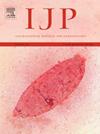SnROP9的特征,SnROP9是神经鞘氨醇沙雷氏菌的一种跳动蛋白同源物,在缺乏跳动细胞器的生命周期阶段表达。
IF 3.2
2区 医学
Q1 PARASITOLOGY
引用次数: 0
摘要
由位于顶端的棒状分泌细胞器释放的蛋白质在顶复合体的宿主细胞入侵和细胞内存活中起着至关重要的作用。神经性肌囊虫是引起马原生动物髓性脑炎(EPM)的顶端复合体,在无性发育阶段,即分裂子和分裂体,缺乏细胞。然而,在S. neurona转录组和蛋白质组中检测到rhoptry蛋白(ROP)同源物,其中SnROP9尤其丰富。在这项研究中,我们进行了体外实验来表征SnROP9,并确定其在裂殖子和分裂体阶段的表达。SnROP9是一个351个氨基酸长的蛋白,具有两个一致的花状蛋白切割基序。分离和分泌实验证实,SnROP9是一种分泌到排泄-分泌部分的可溶性蛋白。神经元s.n neurona分裂子的总裂解液显示全长蛋白在~ 38 kDa和两个额外的肽在~ 30 kDa和25 kDa,与一种茎状加工酶的裂解一致。在分裂体阶段,假定加工过的SnROP9肽的迁移方式与裂殖子不同,并以双重形式出现。在裂殖子中,SnROP9主要定位于顶极,而不与微粒蛋白SnMIC10共定位,这表明SnROP9不通过另一种顶端分泌细胞器微粒进行运输。有趣的是,SnROP9在入侵后不久就重新分布,并在细胞内发育期间保持分散的颗粒状外观。尽管多次尝试,Snrop9的破坏都没有成功,这表明Snrop9可能在S. neurona中发挥重要作用。进一步研究SnROP9和其他蛇状体蛋白同源物将有助于更好地理解它们在神经细胞生物学中的作用,特别是在缺乏蛇状体细胞器的生命周期阶段。本文章由计算机程序翻译,如有差异,请以英文原文为准。

Characterization of SnROP9, a rhoptry protein homologue of Sarcocystis neurona that is expressed in lifecycle stages lacking rhoptry organelles
Proteins released by the club-shaped, apically located, specialized secretory organelles called rhoptries play an essential role in host cell invasion and intracellular survival of apicomplexans. Sarcocystis neurona, the apicomplexan responsible for equine protozoal myeloencephalitis (EPM), lacks rhoptries in its asexual developmental stages, viz., merozoites and schizonts. Nevertheless, rhoptry protein (ROP) homologues were detected in the S. neurona transcriptome and proteome, and SnROP9 was particularly abundant. In this study, we performed in vitro assays to characterize SnROP9 and determine its expression in the merozoite and schizont stages. SnROP9 is a 351 amino acids long protein with two consensus rhoptry protein cleavage motifs. Partition and secretory assays confirmed that SnROP9 is a soluble protein secreted into the excretory-secretory fraction. The total lysate of S. neurona merozoites revealed the full-length protein at ∼38 kDa and two additional peptides at ∼30 kDa and 25 kDa, consistent with its cleavage by a rhoptry processing enzyme. In the schizont stages, the presumed processed SnROP9 peptides migrated differently than in the merozoite and appeared as doublets. In the merozoite, SnROP9 localized predominantly to the apical pole but did not co-localize with the microneme protein, SnMIC10, suggesting that SnROP9 is not trafficked via micronemes, another type of apical secretory organelle. Interestingly, SnROP9 redistributed shortly after the invasion and remained dispersed with a granular appearance throughout the schizont during intracellular development. Despite several attempts, disruption of Snrop9 was unsuccessful, suggesting that there might be an essential role for SnROP9 in S. neurona. Further investigation of SnROP9 and other rhoptry protein homologues will help in better understanding their role in S. neurona biology, particularly in lifecycle stages that lack rhoptry organelles.
求助全文
通过发布文献求助,成功后即可免费获取论文全文。
去求助
来源期刊
CiteScore
8.40
自引率
2.50%
发文量
76
审稿时长
23 days
期刊介绍:
International Journal for Parasitology offers authors the option to sponsor nonsubscriber access to their articles on Elsevier electronic publishing platforms. For more information please view our Sponsored Articles page. The International Journal for Parasitology publishes the results of original research in all aspects of basic and applied parasitology, including all the fields covered by its Specialist Editors, and ranging from parasites and host-parasite relationships of intrinsic biological interest to those of social and economic importance in human and veterinary medicine and agriculture.

 求助内容:
求助内容: 应助结果提醒方式:
应助结果提醒方式:


